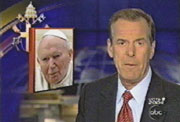 |
|||||||||||||||
|
|||||||||||||||
 |
||
|
 |
||||||||||||
|
||||||||||||
 |
|||||||||||||||||||||||||||||||||||||||
|
|||||||||||||||||||||||||||||||||||||||
|
Religion on TV News:
More Content, Less Context
By Tim
Graham
April 6, 2004
|
Executive Summary
The major findings include: 1. Religion coverage has more than doubled from ten years ago. Overall, the networks aired 699 segments in the study period, up from 336 in 1993. The number of evening news stories on the three networks is up fairly dramatically (121 in 1993, 303 in the 2003-04 period). The number of religion segments on prime-time magazine shows and late-night and Sunday interview shows is way up (18 in 1993 to 65 in the 2003-04 period). A smaller jump came on the morning shows (197 in 1993, 331 in the 2003-04 period). 2. The Catholic Church received the most coverage among faiths, but coverage of Islam rose dramatically. The 25th anniversary of Pope John Paul II's pontificate drew significant coverage with a balance of positive and negative angles. Media outlets continued to press stories on Catholic clergy sexual abuse and other ministerial failings. Coverage of Islam was up dramatically from ten years ago, even if it was largely contained to Iraq. The handful of stories on Islam in America mainly portrayed Muslims as victims of discrimination by non-Muslims. 3. Reporters often approached religious issues from a secular and political perspective. When the Episcopalian Church USA appointed openly gay Bishop Gene Robinson, reporters focused relentlessly on the political, not scriptural or theological matters. Most of the TV interview time went to Robinson and his supporters (ten interviews to just one for a neutral church spokesman and one for an opponent). In news stories, the talking heads were almost balanced between supporters and opponents (39 to 45), but the labeling was very imbalanced (42 “conservative” labels for opponents to five “liberal” labels for the church or Robinson’s supporters). 4. The tone of network TV religion coverage was hostile to orthodox faiths, and supportive to minority religions and progressive fads. Gibson’s movie was by far the largest anti-Semitism story of the year. News coverage didn’t shift from offending Jews to inspiring Christians until February, when a box-office boom became apparent. A much less orthodox product, author Dan Brown’s Vatican-bashing novel The Da Vinci Code, was promoted with the mildest of factual challenges, without any notion that it was inaccurate or anti-Catholic, while Gibson’s film was questioned thoroughly about its accuracy, its fairness, and its potentially violent impact. 5. The media’s Rolodex of religion experts was dominated by those hostile to religious orthodoxy. The networks heavily favored “religious” scholars and journalists who strongly question orthodox religion and the accuracy of the Gospels, but did not describe them as liberals or secularists. The MRC Special Report concludes with four ways the networks could improve their coverage of religion in the future: hire a full-time religion correspondent; hire reporters who are themselves religious; present the religious dimensions of social issues instead of focusing solely on political elements; and present viewers with a balance of religious experts, not just a few favored (generally liberal) theologians.
Home | News Division
| Bozell Columns | CyberAlerts |
||||





 In recent months, a number of dramatic religious stories have unfolded, from religious freedom in Iraq, to the installation of an openly gay
bishop to the religious and commercial phenomenon around Mel Gibson's movie
The Passion of the Christ. To measure the upsurge in religion coverage in 2003 and the beginning of 2004,
Media Research Center analysts surveyed every religion news story on ABC, CBS, and NBC news programs in the 12 months from March 1, 2003 through February 29, 2004. We then compared those numbers to MRC’s first religion news study of 1993.
In recent months, a number of dramatic religious stories have unfolded, from religious freedom in Iraq, to the installation of an openly gay
bishop to the religious and commercial phenomenon around Mel Gibson's movie
The Passion of the Christ. To measure the upsurge in religion coverage in 2003 and the beginning of 2004,
Media Research Center analysts surveyed every religion news story on ABC, CBS, and NBC news programs in the 12 months from March 1, 2003 through February 29, 2004. We then compared those numbers to MRC’s first religion news study of 1993.